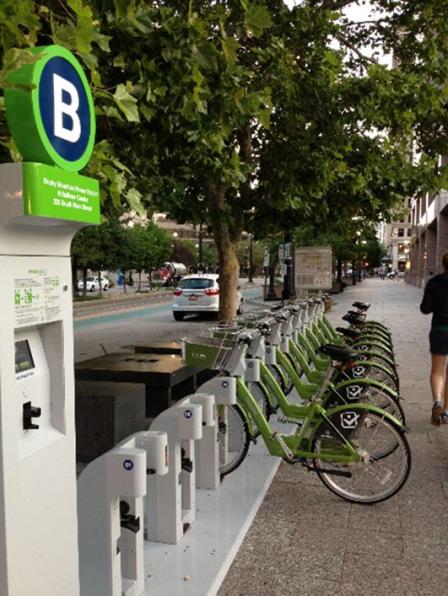Salt Lake City, Utah Adapts to Improve Air Quality Through Smart Growth
 Salt Lake City’s GREENbike bike share program.In 2014, Salt Lake City was designated a Climate Action Champion Community for their leadership in reducing emissions and increasing climate resilience and adaptation to air quality concerns from climate change. The Sustainable Salt Lake Plan 2015 articulates the city’s broad and ambitious agenda to protect its resources, enhance its assets, and establish a path towards greater community resiliency. The plan set goals to improve air quality, protect community health, and reduce particulate matter (PM) and ozone pollution (which are both projected to be exacerbated by climate change). The city adopted specific transportation measures to decrease miles traveled, reduce vehicle idling, and promote alternatives. These clean air strategies reduce current air pollution (mitigation) that is expected to be exacerbated by climate change (adaptation).
Salt Lake City’s GREENbike bike share program.In 2014, Salt Lake City was designated a Climate Action Champion Community for their leadership in reducing emissions and increasing climate resilience and adaptation to air quality concerns from climate change. The Sustainable Salt Lake Plan 2015 articulates the city’s broad and ambitious agenda to protect its resources, enhance its assets, and establish a path towards greater community resiliency. The plan set goals to improve air quality, protect community health, and reduce particulate matter (PM) and ozone pollution (which are both projected to be exacerbated by climate change). The city adopted specific transportation measures to decrease miles traveled, reduce vehicle idling, and promote alternatives. These clean air strategies reduce current air pollution (mitigation) that is expected to be exacerbated by climate change (adaptation).
While continuing to address air quality issues, Salt Lake City is now formulating a vulnerability assessment and adaptation plan. The Salt Lake City Climate Response Plan is expected to include: a climate vulnerability assessment, a greenhouse gas mitigation plan, and an adaptation plan. This comprehensive approach to climate adaptation builds off of previous adaptation efforts to better help the city anticipate, plan and prepare to take action to protect residents from future public health and air quality concerns.
- Climate Action Champion Community
- Sustainable Salt Lake Plan 2015 (PDF)(30 pp, 23 MB, About PDF) Exit
| How Did They Do It? | Applicable EPA Tools |
|---|---|
Salt Lake City identified air quality as a critical vulnerability
|
EPA’s Community-Based Climate Adaptation Handout helps communities identify how local government services may be vulnerable to changing climate conditions. |
Salt Lake City prioritized adaptation actions that provide co-benefits
|
EPA’s smart growth program provides resources on how communities can implement smart growth strategies that provide co-benefits to air, water and public health. |
Similar Cases and More Information
To read more about Salt Lake City's efforts to reduce transportation related air emissions, see the EPA's Sustainable Transportation for a Sustainable Future Page. Salt Lake City implemented air quality actions which also provided mutual benefits as climate mitigation activities. For an example of other strategy that can provide co-benefits, see how Chicago used Green Infrastructure to Reduce Extreme Heat. If you would like to know more information about how climate change will affect Air Quality and Human Health view the ARC Homepage.
- EPA's Sustainable Transportation for a Sustainable Future Page
- See how Chicago used Green Infrastructure to Reduce Extreme Heat
- See how Central New Mexico is working to improve air quality by accounting for future climate change in the city’s transportation plans and ongoing projects

